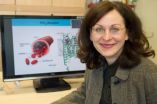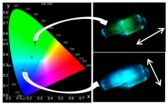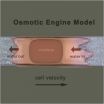(Press-News.org) University of California, Berkeley, geologist William Dietrich pioneered the application of airborne LIDAR – light detection and ranging – to map mountainous terrain, stripping away the vegetation to see the underlying ground surface.
But that didn't take him deep enough. He still couldn't see what was under the surface: the depth of the soil, the underlying weathered rock and the deep bedrock.
He and geology graduate student Daniella Rempe have now proposed a method to determine these underground details without drilling, potentially providing a more precise way to predict water runoff, the moisture available to plants, landslides and how these will respond to climate change.
The technique, which will help improve climate models that today take into account only the soil layer, was published online last week in the Early Edition of the journal Proceedings of the National Academy of Sciences.
A major challenge to including groundwater in climate models, said Rempe, is determining the thickness of weathered bedrock, which can hold most of the water on hillsides, especially during California's dry summers. Their model proposes that the thickness of weathered bedrock under hillslopes is controlled from the bottom up, as opposed to the current view that water from above drives weathering of the bedrock.
"By understanding how water is routed within hillslopes, we can improve predictions of how vegetation and stream flow will respond to climate and land use changes," she said. "But a critical input to hydrologic and climate models is the thickness of soil and weathered bedrock. This model provides, for the first time, a simple theory based on groundwater drainage to predict this thickness across landscapes."
Erosion from the bottom up
The UC Berkeley model emerged from decades of study at various sites where the ground surface is actively eroding, primarily the University of California's Angelo Coast Range Reserve near Laytonville, Calif., and a similar steep, forested area near Coos Bay, Ore. The results apply to mountainous topography across the world, including the Appalachians and Sierra Nevada in the United States.
Soil – a mix of organic material and weathered rock – is traditionally thought of as the key to the landscape, the place where plant roots obtain water and nutrients, the source of runoff into streams, and the material that erodes and occasionally slides. But in recent years, geologists have come to realize that the often thicker layer of weathered bedrock that lies under the soil – and is in the process of becoming soil – often plays a larger role for plants and the watershed. Roots often penetrate though soil to the weathered rock, and research by Rempe and Dietrich reveals that rock can store water far longer than soil.
"The soil is often a thin veneer on the landscape, but it may not be where the hydrologic action is taking place," Rempe said, noting that the soil at the Angelo site may be less than two feet thick, but the weathered bedrock layer is up to 80 feet thick. "The 100-foot-tall Douglas firs are not getting all of their water from the soil. It is just too thin."
Dietrich and Rempe propose in their model that the thickness of the weathered rock is determined primarily by the rate at which water drains from the solid but water-saturated bedrock beneath. This water can be hundreds of thousands of years old and moves through the rock extremely slowly, sometimes less than a millimeter per year. As the bedrock is uplifted by tectonic forces, water drains from the top, leaving dry rock subject to fracturing and chemical weathering. Fracturing allows water, gases, and plant roots to penetrate from above and easily transform the rock through weathering processes.
Bedrock doesn't drain, however, unless stream channels cut into the rock and provide a place to drain. To predict the thickness of weathered bedrock, their model needs only the rate at which channels incise and the rate at which the bedrock drains, determined by the porosity and permeability of the rock.
Focus on rock moisture
"This is a first step towards calculating the thickness of weathered bedrock across the landscape, a zone where we have documented 'rock moisture' dynamics, something we think is missing from current climate models," said Dietrich, a professor of earth and planetary science. "This rock moisture can be used by trees and may contribute to sustained base flow in streams as it slowly drains, yet it is virtually unknown."
One prediction of the model that is consistent with observations is that the weathered rock layer thickens towards the ridges that divide hillslopes.
"We are attempting to explain why some landscapes are covered with soil and deep weathered bedrock while others have bare fresh bedrock exposed at the surface," Rempe added. "Our hypothesis is that the primary control is the relative rate of surface erosion versus drainage of underlying fresh bedrock."
Dietrich and Rempe hope to drill at ridge tops to measure the thickness of weathered rock in order to test their model and confirm the key role played by drainage of fresh bedrock in setting the thickness of weathered bedrock across hilly and mountainous landscapes.
INFORMATION:The work was supported by the Keck Foundation, through the Keck Hydrowatch project; the National Center for Earth-Surface Dynamics; the National Center for Airborne Laser Mapping; and the National Science Foundation, through the Eel River Critical Zone Observatory. Rempe received support from the Department of Energy Office of Science Graduate Fellowship Program, made possible in part by the American Recovery and Reinvestment Act of 2009.
Seeing the bedrock through the trees
Bottom-up model predicts depth to fresh bedrock under hillslopes
2014-04-30
ELSE PRESS RELEASES FROM THIS DATE:
Hope for better drugs to treat stroke and heart attacks
2014-04-30
An international team of researchers in cooperation with the University of Bonn has taken two "snapshots" of a receptor which are of critical importance for blood coagulation. The scientists now hope to be able to develop novel drugs using these results. These include tailor-made blood-thinning substances for heart attack and stroke patients whose effects are reversible and better controllable than those of current therapies. The researchers are presenting their results in the renowned journal "Nature."
After a cut to the finger, blood platelets come into play: they adhere ...
Should the EU ban on the import of seal products stand?
2014-04-30
Next month, following an appeal by Canada and Norway to overturn the EU ban on the import of seal products, the World Trade Organization (WTO) is expected to announce whether the 2013 decision will be upheld. In an editorial article, a University of Bristol academic, whose research on the animal welfare of the seal hunt has been used in the case, explains why the ban should stand.
The article by Dr Andy Butterworth, Senior Lecturer in Animal Sciences at the University of Bristol's School of Veterinary Sciences and an official observer of the seal hunt is published in ...
Prostate cancer and blood lipids share genetic links
2014-04-30
Numerous studies have suggested a relationship between cardiovascular disease risk factors and prostate cancer. A new study by researchers at the University of California, San Diego School of Medicine, with colleagues in Norway, significantly refines the association, highlighting genetic risk factors associated with low density lipoprotein (LDL) cholesterol and triglycerides as key players and identifying 17 related gene loci that make risk contributions to levels of these blood lipids and to prostate cancer
The findings, published in the April 30, 2014 online issue of ...
New hybrid material that changes colour according to the direction of the light
2014-04-30
This news release is available in Spanish. The aim with respect to hybrid materials with one organic component and another inorganic one is to combine the best attributes of each one into a single system. Labs across the world are working to develop new hybrid materials for technological applications in nanotechnologies, in particular, and these materials are already being used in lightweight materials for cars, sports equipment, in biomimetic materials, like prostheses, etc.
The hybrid material being sought after by the research group in the Department of Physical ...
Neanderthals were not inferior to modern humans, says CU-Boulder study
2014-04-30
The embargo has been lifted for the article, 'Neandertal Demise: An Archaeological Analysis of the Modern Human Superiority Complex.'
If you think Neanderthals were stupid and primitive, it's time to think again.
The widely held notion that Neanderthals were dimwitted and that their inferior intelligence allowed them to be driven to extinction by the much brighter ancestors of modern humans is not supported by scientific evidence, according to a researcher at the University of Colorado Boulder.
Neanderthals thrived in a large swath of Europe and Asia between about ...
Columbia engineers grow functional human cartilage in lab
2014-04-30
New York, NY—April 30, 2014—Researchers at Columbia Engineering announced today that they have successfully grown fully functional human cartilage in vitro from human stem cells derived from bone marrow tissue. Their study, which demonstrates new ways to better mimic the enormous complexity of tissue development, regeneration, and disease, is published in the April 28 Early Online edition of Proceedings of the National Academy of Sciences (PNAS).
"We've been able—for the first time—to generate fully functional human cartilage from mesenchymal stem cells by mimicking in ...
Throwing injuries no longer just for the pros
2014-04-30
ROSEMONT, Ill.—Baseball season is back and so are the injuries. But, elbow injuries, once seen as a problem for professional athletes, are becoming more prevalent among high school and middle school athletes due to increased play and competition at the youth level. Repetitive stress to a pitcher's ulnar collateral ligament (UCL)—an important stabilizing ligament of the elbow joint—can lead to pain and eventually to the inability to pitch and throw.
According to a literature review in the May 2014 issue of the Journal of the American Academy of Orthopaedic Surgeons (JAAOS), ...
Research finds a way to protect crops from pests and disease
2014-04-30
A team of international researchers has uncovered a mechanism by which plants are able to better defend themselves against disease-causing pathogens.
The work, led by Dr Jurriaan Ton and Dr Estrella Luna at the University of Sheffield, has identified the key receptor binding a chemical called BABA (β-aminobutyric acid) which is boosting plant immunity.
BABA has long been known for its protective effects against devastating plant diseases, such as potato blight, but has so far not been used widely in crop protection because of undesirable side effects.
"We have ...
Robots may need to include parental controls
2014-04-30
Older adults' fears that companion robots will negatively affect young people may create design challenges for developers hoping to build robots for older users, according to Penn State researchers.
Companion robots provide emotional support for users and interact with them as they, for example, play a game, or watch a movie.
Older adults reported in a study that while they were not likely to become physically and emotionally dependent on robots, they worried that young people might become too dependent on them, said T. Franklin Waddell, a doctoral candidate in mass ...
Water-based 'engine' propels tumor cells through tight spaces in the body
2014-04-30
Johns Hopkins researchers have discovered a new mechanism that explains how cancer cells spread through extremely narrow three-dimensional spaces in the body by using a propulsion system based on water and charged particles.
The finding, reported in the April 24 issue of the journal Cell, uncovers a novel method the deadly cells use to migrate through a cancer patient's body. The discovery may lead to new treatments that help keep the disease in check. The work also points to the growing importance of studying how cells behave in three dimensions, not just atop flat two-dimensional ...
LAST 30 PRESS RELEASES:
Air pollution exposure and birth weight
Obstructive sleep apnea risk and mental health conditions among older adults
How talking slows eye movements behind the wheel
The Ceramic Society of Japan’s Oxoate Ceramics Research Association launches new international book project
Heart-brain connection: international study reveals the role of the vagus nerve in keeping the heart young
Researchers identify Rb1 as a predictive biomarker for a new therapeutic strategy in some breast cancers
Survey reveals ethical gaps slowing AI adoption in pediatric surgery
Stimulant ADHD medications work differently than thought
AI overestimates how smart people are, according to HSE economists
HSE researchers create genome-wide map of quadruplexes
Scientists boost cell "powerhouses" to burn more calories
Automatic label checking: The missing step in making reliable medical AI
Low daily alcohol intake linked to 50% heightened mouth cancer risk in India
American Meteorological Society announces Rick Spinrad as 2026 President-Elect
Biomass-based carbon capture spotlighted in newly released global climate webinar recording
Illuminating invisible nano pollutants: advanced bioimaging tracks the full journey of emerging nanoscale contaminants in living systems
How does age affect recovery from spinal cord injury?
Novel AI tool offers prognosis for patients with head and neck cancer
Fathers’ microplastic exposure tied to their children’s metabolic problems
Research validates laboratory model for studying high-grade serous ovarian cancer
SIR 2026 delivers transformative breakthroughs in minimally invasive medicine to improve patient care
Stem Cell Reports most downloaded papers of 2025 highlight the breadth and impact of stem cell research
Oxford-led study estimates NHS spends around 3% of its primary and secondary care budget on the health impacts of heat and cold in England
A researcher’s long quest leads to a smart composite breakthrough
Urban wild bees act as “microbial sensors” of city health.
New study finds where you live affects recovery after a hip fracture
Forecasting the impact of fully automated vehicle adoption on US road traffic injuries
Alcohol-related hospitalizations from 2016 to 2022
Semaglutide and hospitalizations in patients with obesity and established cardiovascular disease
Researchers ‘listen in’ to embryo-mother interactions during implantation using a culture system replicating the womb lining
[Press-News.org] Seeing the bedrock through the treesBottom-up model predicts depth to fresh bedrock under hillslopes



